Zanussi FA 622 User Manual [ru]
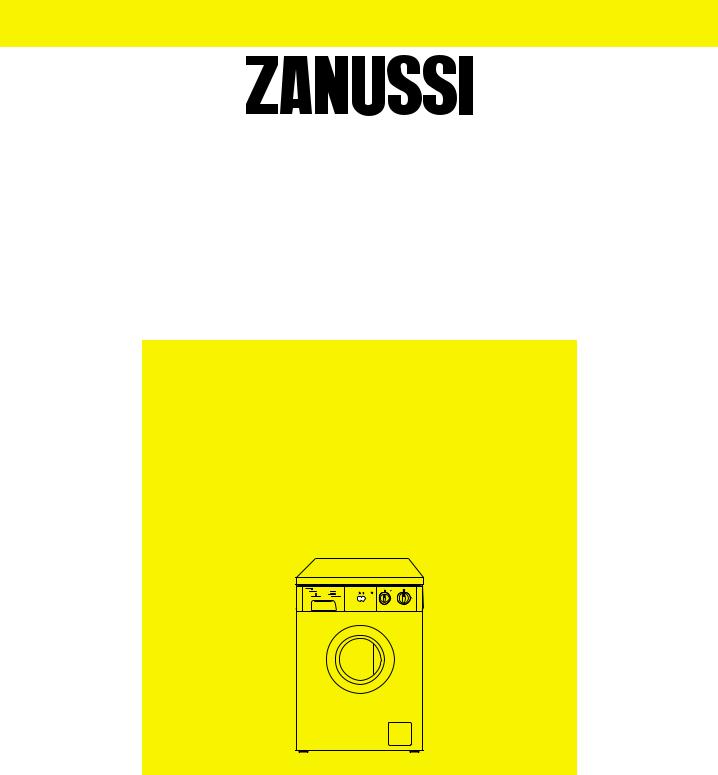
WASHING MACHINE
ЫЕШКФДЦТФÅ ЬФfiШТФ
FA 522 - FA 622
°0
3 ° 40
N 
M
L
FG
USER MANUAL
35.292.714/0 КГЛЩМЩВЫЕМЩ ЗЩ ÈЛЫЗДГФЕФСШШ

Dear customer,
Please read these operating instructions carefully and pay particular attention to the safety notes indicated in the first pages. We recommend that you keep this instruction booklet for future reference and pass it on to any future owners.
Transport damages
When unpacking the appliance, check that it is not damaged. If in doubt, do not use it and contact the Service Centre.
The symbols you will see on some paragraphs of this booklet have the following meaning:
The warning triangle and/or the key words (Warning!, Caution!) emphasize information that is particularly important for your safety or correct functioning of the appliance.
The information marked with this symbol provides additional instructions and practical tips on the use of the appliance.
Tips and information about economical and ecological use of the machine are marked with this symbol.
Our contribution to the protection of the environment: we use recycled paper.
2

Contents
Warnings |
4-5 |
Disposal |
5 |
Tips for environmental protection 5
Technical specifications |
6 |
Installation |
7-8 |
Unpacking |
7 |
Hydraulic connection |
7 |
Levelling |
8 |
Electrical connection |
8 |
Your new washing machine |
9 |
Description of the appliance |
9 |
Detergent dispenser drawer |
9 |
Use |
10 |
Control panel |
10 |
Controls |
10 |
Washing hints |
11 |
Sorting the laundry |
11 |
Temperatures |
11 |
Before loading the laundry |
11 |
Maximum loads |
11 |
Laundry weights |
11 |
Removing stains |
11 |
Detergents and additives |
12 |
International wash code symbols |
13 |
Operating sequence |
14-15 |
Washing programmes |
16-17 |
Maintenance
Bodywork
Detergent dispenser drawer Cleaning of the drainage area Water inlet filter
Frost precautions
Emergency emptying out
Something not working?
18 |
ENGLISH |
|
18
18
18
19
19
19
20-21
3
 Warnings
Warnings
The following warnings are provided in the interests of overall safety. You must read them carefully before installing or using the appliance.
Installation
•All internal packing must be removed before using the appliance. Serious damage may be caused to the machine or adjacent furniture if the protective transit devices are not removed or are not completely removed. Refer to the relevant paragraph in the instruction book.
•Any electrical work required to install this appliance must be carried out by a qualified electrician.
•Any plumbing work required to install this appliance must be carried out by a qualified plumber.
•After having installed the machine, check that it is not standing on its electrical supply cable.
•If the appliance is placed on a carpeted floor, ensure that air can circulate freely between the feet and the floor.
Use
•This appliance is designed for domestic use. It must not be used for purposes other than those for which it was designed.
•Only wash fabrics which are designed to be machine washed. Follow the instructions on each garment label.
•Do not overload the appliance. Follow the instructions in the instruction book.
•Make sure that all pockets are empty. Objects such as coins, safety pins, pins and screws can cause extensive damage.
•Do not machine wash garments saturated with petroleum, methylated spirits, trichlorethylene, etc. If such fluids have been used to remove stains prior to washing, wait until they have completely evaporated from the fabric before placing garments in the appliance.
•Place small items such as socks, belts, etc. in a cloth bag or pillowcase to prevent them getting trapped between the drum and the tub.
•Use only the recommended quantities of fabric softener. An excessive amount could damage the laundry.
•Leave the porthole door slightly ajar when the appliance is not in use. This preserves the door seal and prevents the formation of musty smells.
•Always check that water has emptied out before opening the door. If not, drain the water following the instructions in the instruction book.
•Always unplug the appliance and shut the water tap after use.
General safety
•Repairs to the machine must be carried out only by qualified personnel. Repairs carried out by inexperienced persons could cause serious danger. Contact your local Service Centre.
•Never pull the power supply cable to remove the plug from the socket; always take hold of the plug itself.
•During high temperature wash programmes the door glass may get hot. Do not touch it!
4

Child safety
•Children are often not aware of how dangerous electrical appliances can be. When the machine is working, children should be carefully supervised and not be allowed to play with the appliance.
•The packaging components (e.g. plastic film, polystyrene) can be dangerous to children - danger of suffocation! Keep them out of children’s reach.
•Keep all detergents in a safe place out of children’s reach.
•Make sure that children or pets do not climb into the drum.
•When the appliance is to be scrapped, cut off the electrical supply cable and destroy the plug with the remaining cable. Disable the door catch in order to prevent children from becoming trapped inside while playing.
 Disposal
Disposal
Packaging materials
The materials marked with the symbol  are recyclable.
are recyclable.
>PE<=polyethylene
>PS<=polystyrene
>PP<=polypropylene
This means that they can be recycled by disposing of them properly in appropriate collection containers.
Machine
Use authorised disposal sites for your old appliance. Help to keep your country tidy!
 Tips for environmental protection
Tips for environmental protection
To save water, energy and to help protect the environment, we recommend that you follow these tips:
•Normally soiled laundry may be washed without prewashing in order to save detergent, water and time (the environment is protected too!).
•The machine works more economically if it is fully loaded.
•With adequate pre-treatment, stains and limited soiling can be removed; the laundry can then be washed at a lower temperature.
•Measure out detergent according to the water hardness, the degree of soiling and the quantity of laundry being washed.
ENGLISH
5
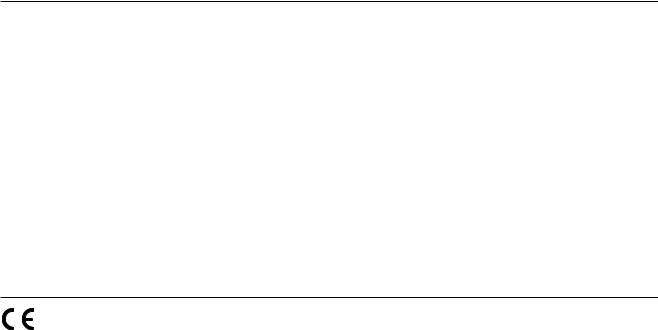
Technical specifications
DIMENSIONS |
Height |
85 cm |
|
Width |
60 cm |
|
Depth |
60 cm |
|
|
|
MAXIMUM LOAD |
Cotton |
4,5 kg |
|
Synthetics |
2 kg |
|
Delicates |
2 kg |
|
Woollens |
1 kg |
|
|
|
SPIN SPEED |
FA 522 |
500 rpm max. |
|
FA 622 |
600 rpm max. |
|
|
|
POWER SUPPLY VOLTAGE/FREQUENCY |
220-230 V/50 Hz |
|
TOTAL POWER ABSORBED |
|
2100 W |
MINIMUM FUSE PROTECTION |
|
10 A |
|
|
|
WATER PRESSURE |
Minimum |
5 N/cm2 |
|
Maximum |
80 N/cm2 |
This appliance complies with the following EEC Directives: 73/23/EEC of 19/02/73 relating to low voltage
89/336/EEC of 03/05/89 relating to electromagnetic compatibility.
6
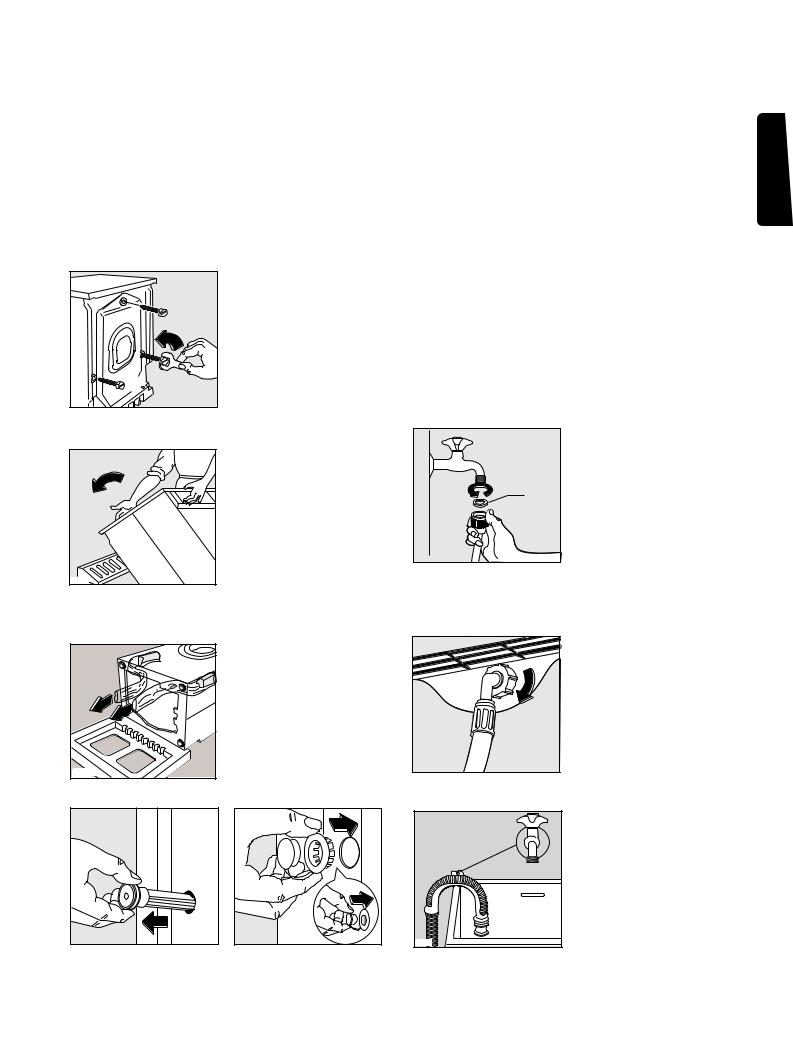
Installation
Transit security bars
Before starting the machine up, the transport security bars must be removed as follows: You are advised to keep all the transport security bars in case the appliance has to be transported again.
P0287 |
1.Unscrew and remove the three rear screws by means of a key.
P0018 |
1 2 |
AL009 |
2.Lean the appliance back on the rear and fit one of the polystyrene angles between the appliance and the floor.
Make sure the hoses are not squashed.
3.Carefully remove the plastic bags on the right and the left, pulling them to the centre of the appliance
P0001 |
P0002 |
4.Place the machine in an upright position and remove the three plastic bolts.
5.Plug the 3 holes with the plastic plugs which you can find in the envelope containing the instruction booklet.
Hydraulic connection
There should be a COLD WATER tap near the washing machine with a screwing on connection pipe of 3⁄4” gas for the water supply, a sink, a wash basin or a drainage system in the wall.
Previously check if:
—it is not a hot water tap.
—the running water is clean. If not, run off a reasonable amount of water to flush out any debris that may have collected in the pipes.
Have the permanent drainage system in the wall checked by a plumber.controlar su buen estado por un fontanero.
A |
AL013 |
A) Place the enclosed rubber joint, delivered in a plastic bag together with the appliance (A) Fig.6), at the very end of the inlet hose and carefully screw the pipe to the tap taking care not to damage the screwdrive and fix the nut well on to the end in order to avoid leaking.
P0021 |
P0022 |
B)If necessary turn the hose adequately by unscrewing the nut at the rear of the appliance.
C)Now tighten the nut anew to avoid leaks. (Open the tap and asure that it does not leak and close it again.)
D)Place the discharging hose in a washbasin or sink with the aid of the bent piece delivered separately. The bent piece has to be entered into the tube’s mouth in order to assure the support. Aforesaid piece allows the hose to be fixed to the wall by means of an opening on the upper part and that way the hose does not move and its falling is avoided.
ENGLISH
7
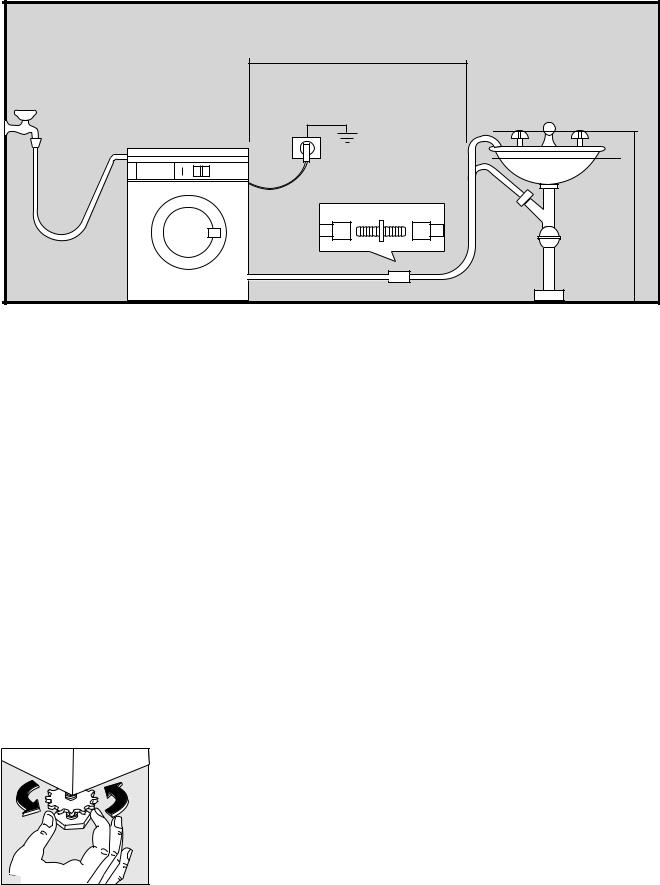
1,5 m. Max. |
|
60 cm. Min. |
90 cm. Max. |
IMPORTANT: The distance from the floor to the highest part of the hose should be between 60 to 90 cm. (It is advised to be between 60 and 70 cm). The hose must not be bent nor twisted to avoid clogging. Should a prolongation of the discharging hose be unavoidable this must never surpass 1.5 m and must be of the same diameter as the original hose.
Make sure the hoses are not too tense.
Levelling
Level the appliance by loosening or tightening the feet. Once in the right position fix the feet by pushing the nuts against the base of the case. Accurate levelling will prevent vibration, noise and displacement of the appliance during operation.
Some vibration is inevitable, especially if placed on a wooden floor. Wooden floors are particularly susceptible to vibrations. For advice, consult a builder. If posible always place the appliance on a solid floor.
Electrical connections
Before plugging the appliance make sure that:
1º. the mains of your installation is the same as on the rating plate of your appliance (the plate is sticked to the rear of the appliance).
2º. The meter, the fuses, the wiring and the socket outlet can support the max. power absorbed stated on the rating plate.
3º. The socket base and the plug must fit in adequately without any reducing interposition, multiple outlets or adapters. If necessary replace the socket outlet by an adequate one.
The applicable rules for electrical security require an adequate earthing. The plug of the appliance is provided with such a device.
Make sure your socket outlet is provided with an adquate earthing too.
The manufacturer declines any liability in case of accidents or incicents should these safety measures not be observed.
8
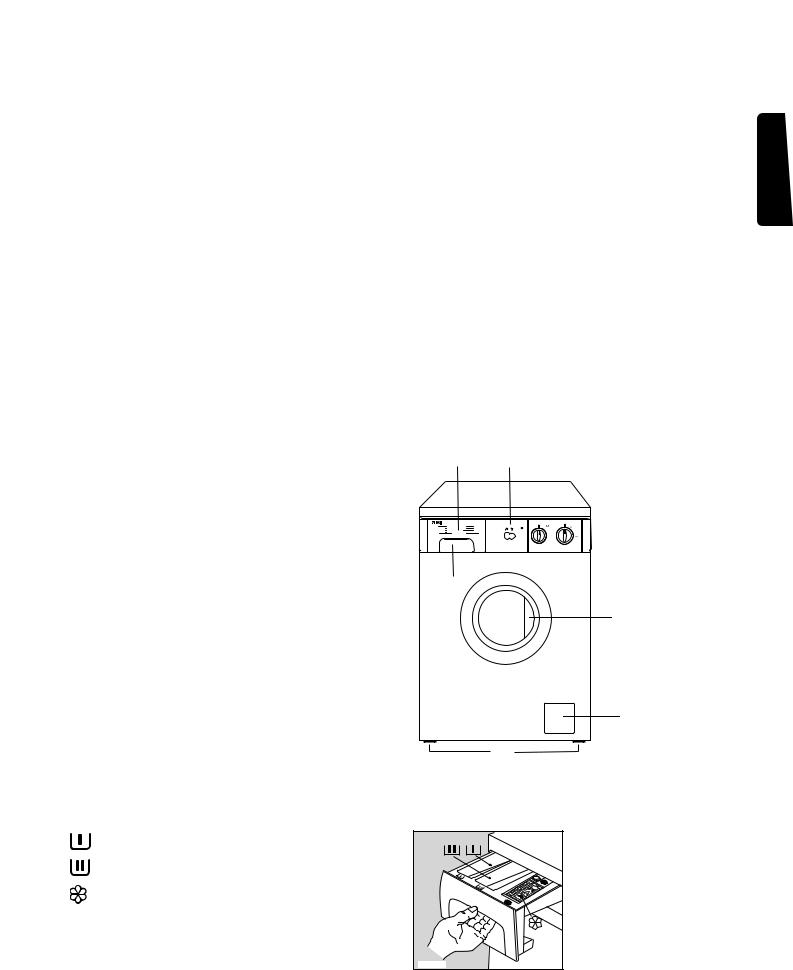
Your new washing machine
This new machine meets all modern requirements for effective treatment of laundry with low water, energy and detergent consumption.
• The temperature selector dial will allow you to choose the most suitable temperature for your laundry.
ENGLISH
Description of the appliance
1 Detergent dispenser drawer
2 Programme chart
3 Control panel
4 Door handle
5 Drainage area door
6 Adjustable feet
Detergent dispenser drawer
2 3
|
60°-90° B |
|
30°-60° J |
|
|
|
|
|
|
|
|
|
40°-60° B |
|
30°-40° K |
|
|
|
|
|
B |
A P |
N |
|
30°-40° C |
|
30°-40° L |
|
|
|
|
|
|
|
M |
|
60°-90° A |
|
30°-60° H |
|
|
|
|
|
|
|
L |
|
D |
|
M |
° |
|
|
|
D |
|
|
K |
F |
G |
N |
P |
|
|
|
|
|
|
||
|
|
|
|
03 |
|
|
|
|
|
|
|
|
|
|
|
°40 |
°50 |
0° |
6 |
F |
GH |
J |
|
|
|
|
|
|
|
|
1
4
5
6
Prewash
Main wash
Fabric softener, starch
R0001 3D |
9
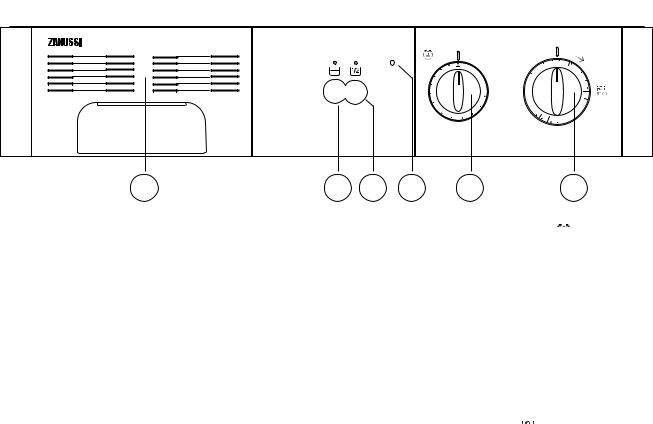
Use
Control panel
° |
|
|
|
|
90 |
30 |
|
|
|
80 |
° |
|
|
|
|
|
|
° |
|
|
70 |
° |
|
40 |
°50 |
06 |
° |
|
|
|
|
° |
|
|
|
C
 D
D
F
B |
A |
|
G |
H |
|
 P
P
J
N
M
L
K
1
1. Programme chart
It will help you to choose the most suitable washing programme for your laundry.
2. RINSE HOLD button 
(Easy iron. If you use this button it will be easier to iron the fabrics later).
Pressing this button together with the programs for delicate fabrics, the water will hold up in the wash tub at the end of the cycle. Press again to drain the water and take out the clothes.
3.  button
button
Pressing this button before starting the intense program there will be one rinse less which leads to energy and water saving.
4. On/off lamp
It lights when the appliance is operating.
2 |
3 |
4 |
5 |
6 |
5. Temperature selector 
This control allows you to select the temperature of the washing cycle in accordance with the kind of clothes to be washed.
Turn the control until the required temperature coincides with the marker.
On the program table you will find the most apropriate temperature for each kind of washing. Selecting  any program can be run through with cold water. This will ensure a saving in electricity consumption.
any program can be run through with cold water. This will ensure a saving in electricity consumption.
6. Program selector 
To select the required program turn the control clockwise until the marker on the top coincides with the letter of the required program (reference mark on the control panel). If at any chance you pass by the required letter NEVER TURN THE CONTROL ANTICLOCKWISE just continue clockwise until the required letter is reached again.
10

Washing hints
Sorting the laundry
Follow the wash code symbols on each garment label and the manufacturer’s washing instructions. Sort the laundry as follows:
whites, coloureds, synthetics, delicates, woollens.
Temperatures
90° for normally soiled white cottons and linen (e.g. tea cloths, towels, tablecloths, sheets...)
60° for normally soiled, colour fast garments (e.g. shirts, night dresses, pyjamas....) in linen, cotton or synthetic fibres and for lightly soiled white cotton (e.g. underwear).
 (cold)for delicate items (e.g. net curtains), mixed 30°-40° laundry including synthetic fibres and
(cold)for delicate items (e.g. net curtains), mixed 30°-40° laundry including synthetic fibres and
woollens.
Laundry weights
The following weights are indicative: |
|
bathrobe |
1200 g |
napkin |
100 g |
quilt cover |
700 g |
sheet |
500 g |
pillow case |
200 g |
tablecloth |
250 g |
towelling towel |
200 g |
tea cloth |
100 g |
night dress |
200 g |
ladies’ briefs |
100 g |
man’s work shirt |
600 g |
man’s shirt |
200 g |
man’s pyjamas |
500 g |
blouse |
100 g |
men’s underpants |
100 g |
Before loading the laundry
Never wash whites and coloureds together. Whites may lose their “whiteness” in the wash.
New coloured items may run in the first wash; they should therefore be washed separately the first time.
Make sure that no metal objects are left in the laundry (e.g. hair clips, safety pins, pins).
Button up pillowcases, close zip fasteners, hooks and poppers. Tie any belts or long tapes.
Remove persistent stains before washing. Rub particularly soiled areas with a special detergent or detergent paste.
Treat curtains with special care. Remove hooks or tie them up in a bag or net.
Maximum loads
Recommended loads are indicated in the programme charts.
General rules:
Cotton, linen: drum full but not too tightly packed;
Synthetics: drum no more than half full;
Delicate fabrics and woollens: drum no more than one third full.
Washing a maximum load makes the most efficient use of water and energy.
For heavily soiled laundry, reduce the load size.
Removing stains
Stubborn stains may not be removed by just water and detergent. It is therefore advisable to treat them prior to washing.
Blood: treat fresh stains with cold water. For dried stains, soak overnight in water with a special detergent then rub in the soap and water.
Oil based paint: moisten with benzine stain remover, lay the garment on a soft cloth and dab the stain; treat several times.
Dried grease stains: moisten with turpentine, lay the garment on a soft surface and dab the stain with the fingertips and a cotton cloth.
Rust: oxalic acid dissolved in hot water or a rust removing product used cold. Be careful with rust stains which are not recent since the cellulose structure will already have been damaged and the fabric tends to hole.
Mould stains: treat with bleach, rinse well (whites and fast coloureds only).
Grass: soap lightly and treat with bleach (whites and fast coloureds only).
Ball point pen and glue: moisten with acetone (*), lay the garment on a soft cloth and dab the stain.
Lipstick: moisten with acetone as above, then treat stains with methylated spirits. Remove any residual marks from white fabrics with bleach.
Red wine: soak in water and detergent, rinse and treat with acetic or citric acid, then rinse. Treat any residual marks with bleach.
ENGLISH
11
Ink: depending on the type of ink, moisten the fabric first with acetone (*), then with acetic acid; treat any residual marks on white fabrics with bleach and then rinse thoroughly.
Tar stains: first treat with stain remover, methylated spirits or benzine, then rub with detergent paste.
(*) do not use acetone on artificial silk.
Detergents and additives
Good washing results also depend on the choice of detergent and use of the correct quantities to avoid waste and protect the environment. Although biodegradable, detergents contain substances which, in large quantities, can upset the delicate balance of nature.
The choice of detergent will depend on the type of fabric (delicates, woollens, cottons, etc.), the colour, washing temperature and degree of soiling.
All commonly available washing machine detergents may be used in this appliance:
–powder detergents for all types of fabric,
–powder detergents for delicate fabrics (60°C max) and woollens,
–liquid detergents, preferably for low temperature wash programmes (60°C max) for all types of fabric, or special for woollens only.
The detergent and any additives must be placed in the appropriate compartments of the dispenser drawer before starting the wash programme.
If using concentrated powder or liquid detergents, a programme without prewash must be selected.
The washing machine incorporates a recirculation system which allows an optimal use of the concentrated detergent.
Pour liquid detergent into the dispenser drawer compartment marked  just before starting the programme.
just before starting the programme.
Any fabric softener or starching additives must be poured into the compartment marked  before starting the wash programme.
before starting the wash programme.
The bleaching agent (chlorine) can be used only for white or fast coloured cotton and linen items.
Pour it into the compartment marked  .
.
Follow the product manufacturer’s recommendations on quantities to use and do not exceed the «MAX» mark in the detergent dispenser drawer.
Quantity of detergent to be used
The type and quantity of detergent will depend on the type of fabric, load size, degree of soiling and hardness of the water used.
Water hardness is classified in so-called “degrees” of hardness. Information on hardness of the water in your area can be obtained from the relevant water supply company, or from your local authority.
Follow the product manufacturers’ instructions on quantities to use.
Use less detergent if:
–you are washing a small load,
–the laundry is lightly soiled,
–large amounts of foam form during washing.
Degrees of water hardness
|
|
Degrees |
||
Level |
Characteristic |
|
|
|
German |
French |
|||
|
|
|||
|
|
°dH |
°T.H. |
|
|
|
|
|
|
1 |
soft |
0- 7 |
0-15 |
|
|
|
|||
2 |
medium |
8-14 |
16-25 |
|
|
|
|||
3 |
hard |
15-21 |
26-37 |
|
|
|
|||
4 |
very hard |
more than |
more than |
|
21 |
37 |
|||
|
|
|||
|
|
|
|
|
12

 International wash code symbols
International wash code symbols
These symbols appear on fabric labels, in order to help you choose the best way to treat your laundry.
Energetic wash |
|
|
|
30 |
|
|
95 |
60 |
|
40 |
|
|
|
Max. wash |
Max. wash |
Max. wash |
Max. wash |
|
|
|
temperature |
temperature |
temperature |
temperature |
|
|
|
95°C |
60°C |
|
40°C |
30°C |
|
|
|
60 |
40 |
40 |
30 |
Hand wash |
Do not |
Delicate wash |
|
wash |
||||
|
|
|
|
|
|
at all |
|
|
|
|
|
|
|
|
Bleaching |
Bleach in cold water |
Do not bleach |
|
|
|
|
|
Ironing |
Hot iron |
Warm iron |
Lukewarm iron |
Do not iron |
||||
|
max 200°C |
max 150°C |
max 110°C |
|
||||
|
|
|
|
|
|
|
|
|
|
|
|
|
|
|
|
|
|
|
|
|
|
|
|
|
|
|
|
|
|
|
|
|
|
|
|
|
|
|
|
|
|
|
|
|
Dry cleaning |
Dry cleaning |
Dry cleaning in |
Dry cleaning |
Do not |
|
in all solvents |
perchlorethylene, |
in petrol, |
dry clean |
|
|
petrol, pure alcohol, |
pure alcohol |
|
|
|
R 111 & R 113 |
and R 113 |
|
|
|
|
|
high |
|
|
|
|
|
temperature |
|
|
|
|
|
low |
|
|
|
|
|
temperature |
|
Drying |
Flat |
On the line |
On clothes |
Tumble dry |
Do not |
|
|
|
hanger |
|
tumble dry |
ENGLISH
13
